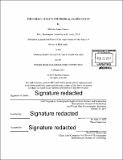The cobalt cycle in the tropical Pacific Ocean
Author(s)
Hawco, Nicholas James
DownloadFull printable version (22.63Mb)
Other Contributors
Woods Hole Oceanographic Institution.
Advisor
Mak A. Saito.
Terms of use
Metadata
Show full item recordAbstract
Although over a dozen elements are needed to support phytoplankton growth, only a few are considered to be growth-limiting. As the central atom in vitamin B12, cobalt is crucial for metabolism, but its status as a limiting nutrient is uncertain. This thesis investigates the geochemical controls on oceanic cobalt scarcity and their biological consequences. Analysis of over 1000 samples collected in the Tropical Pacific Ocean reveals a dissolved cobalt distribution that is strongly coupled to dissolved oxygen, with peak concentrations where oxygen is lowest. Large cobalt plumes within anoxic waters are maintained by three processes: 1) a cobalt supply from organic matter remineralization, 2) an amplified sedimentary source from oxygen-depleted coastlines, and 3) low-oxygen inhibition of manganese oxidation, which scavenges cobalt from the water column. Rates of scavenging are calculated from a global synthesis of recent GEOTRACES data and agree with cobalt accumulation rates in pelagic sediments. Because both sources and sinks are tied to the extent of oxygen minimum zones, oceanic cobalt inventories are likely dynamic on the span of decades. Despite extremely low cobalt in the South Pacific gyre, the cyanobacterium Prochlorococcus thrives. Minimum cobalt and iron requirements of a Prochlorococcus strain isolated from the Equatorial Pacific are quantified. Cobalt quotas are related to demand for ribonucleotide reductase and methionine synthase enzymes, which catalyze critical steps in DNA and protein biosynthesis, respectively. Compared to other cyanobacteria, a streamlined metal physiology makes Prochlorococcus susceptible to competitive inhibition of cobalt uptake by low levels of zinc. Although phytoplankton in the Equatorial Pacific are subject to chronic iron-limitation, widespread cobalt scarcity and vulnerability to zinc inhibition observed in culture imply that wild Prochlorococcus are not far from a cobalt-limitation threshold.
Description
Thesis: Ph. D., Joint Program in Oceanography/Applied Ocean Science and Engineering (Massachusetts Institute of Technology, Department of Earth, Atmospheric, and Planetary Sciences; and the Woods Hole Oceanographic Institution), 2017. Cataloged from PDF version of thesis. Includes bibliographical references.
Date issued
2017Department
Joint Program in Oceanography/Applied Ocean Science and Engineering; Woods Hole Oceanographic Institution; Massachusetts Institute of Technology. Department of Earth, Atmospheric, and Planetary SciencesPublisher
Massachusetts Institute of Technology
Keywords
Joint Program in Oceanography/Applied Ocean Science and Engineering., Earth, Atmospheric, and Planetary Sciences., Woods Hole Oceanographic Institution.